Contact Us
- Address: Réservations par internet seulement
- Email: infoSPAMFILTER@spaceobs.com
- Phone: No telephone
- Cellphone: No telephone
- Website: www.spaceobs.com
Next moons
21-10-2025 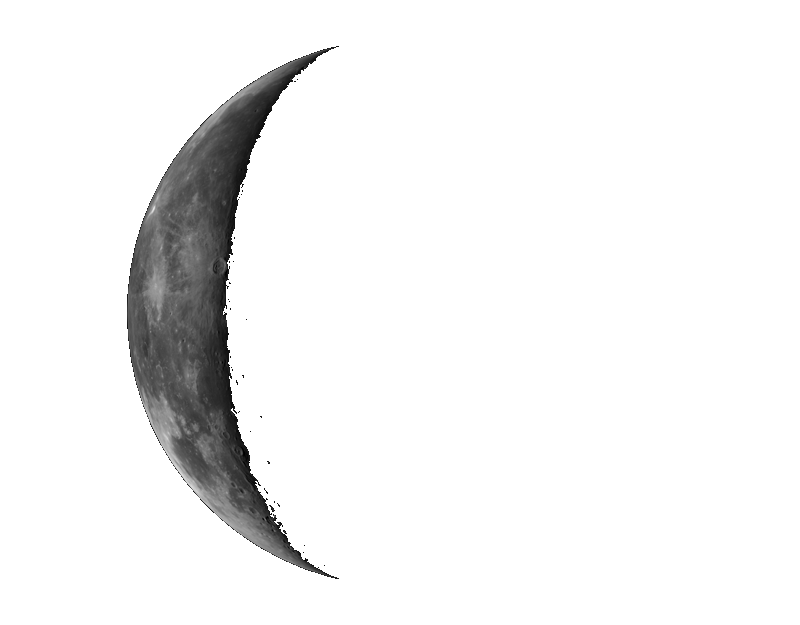 | 29-10-2025 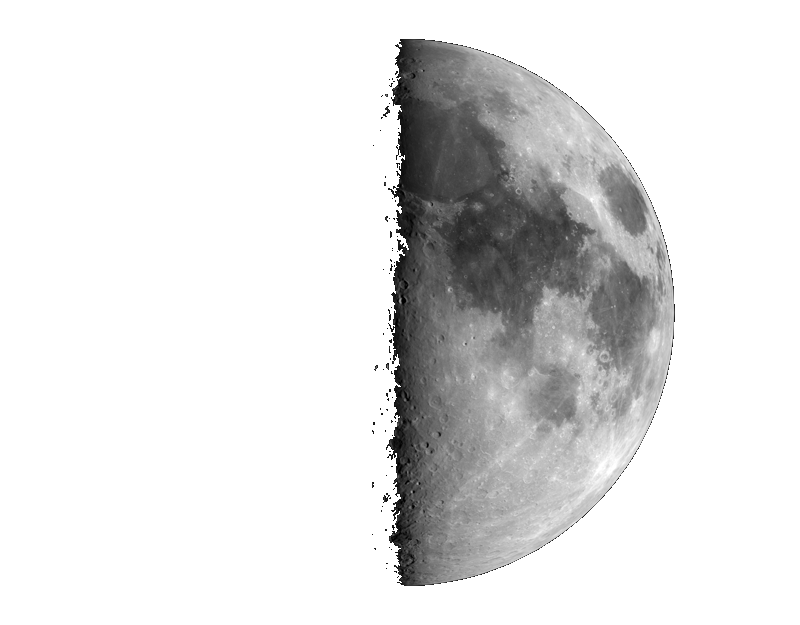 |
05-11-2025  | 12-11-2025 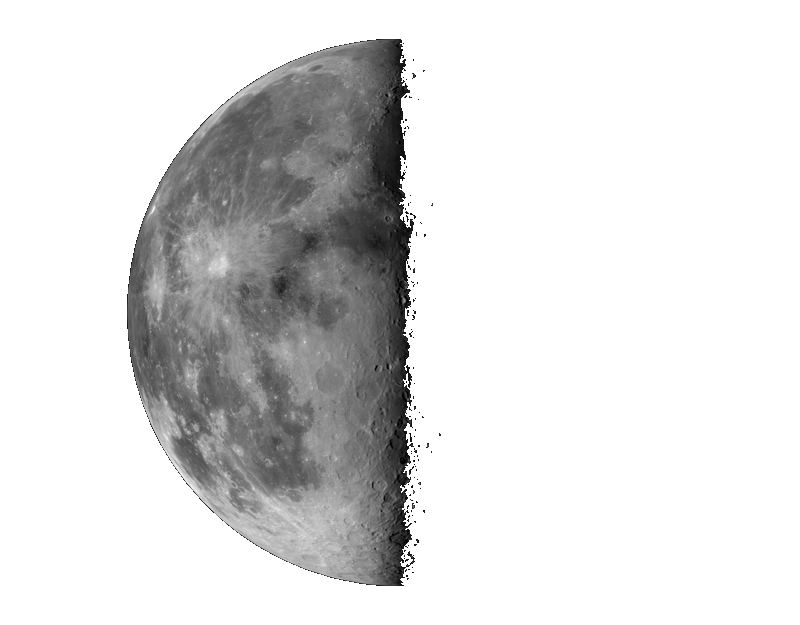 |
Sponsors
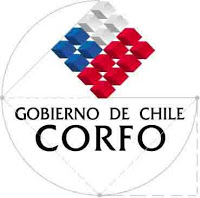
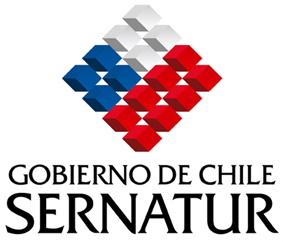
T115
Disclaimer : This page was translated from French. And in France, we normally don’t give the units for the diameter of a telescope. Like : “he has a 200 telescope”, or “il a un telescope de 200”. It is supposed that 200 is in mm. Because no individual has a 200cm (2m) telescope. For user of antique units, it’s also the same thing : “he has a Celestron 8”, which is obviously in inches, not in feet (you wished you had). So the page explains how, when I was beginning in astronomy, I dreamt of having a “telescope de 115” (mm), and now how I have “a telescope de 115” … centimeters.
When I was young, the most common beginner’s telescope was a Japanese made 115mm telescope
Introduction (which you can very well pass ...)
The three years of high school were the 5 most difficult years of my life.
Since June 30, 1973 my life has been devoted to astronomy. On June 30, 1973 for non-astronomers, there was a solar eclipse, visible as partial in France, and I had just returned from my last day of college class, and I "fell in", I saw this eclipse (my father was a welder, so had a mask with a filter allowing the observation of the sun) and for me it triggered an invading passion. Or a passion for short, because there is no real part time passion, otherwise it's called a "hobby" or a pastime. High school, for me and at the time, was therefore a huge waste of time, schedules incompatible with the normal hours of an astronomer, subjects of study completely useless (history geography, foreign languages), or even painful, like sport, some parts of the maths classes.
We were the poor victims of the 1968 reforms that brought us "modern maths", imagined by powerful brains who wanted to show the world that mathematics were not solely some tools for physics. So we were taught weird things which were completely useless except for mathematics researchers. I remember the isomorphisms and other automorphisms, which fortunately were forgotten in high school and are today part of preparatory classes of Math Sup and Spé (before entering engineer’s schools). The truth was also that these teachers of my high school with a few exceptions were relatively mediocre (a posteriori, I allow myself to note them, they who noted me at that time).
1976 was the year of comet West, a "great" comet, and I woke up every morning (morning, like three o'clock in the morning) to see if the sky was clear, and if it was, I silently opened the garage door, took out my telescope, watched it, took photographs, re-entered my room just as quietly, went back to bed, before I "got up" to go to high school, in good shape, or not. I was much more at the high school astronomy club than at the high school itself. The math teacher that year was a frustrated guy who probably had not obtained a position in academia and had to reluctantly accept a high school teacher position and was bored, and, since he didn’t want to be alone in such situation, made a very boring class. I was stressed every time I had to go back to his class. He was very likely good in maths, but was a pedagogical disaster. The history teacher was humming her class, which she read in a monotone voice. Damned, history, if it's well taught, is a very interesting subject. Her class was nothing but boring, the only description suitable for this torture. I had explained to the English teacher that his course was perfectly useless, since I would never have the opportunity to speak English in my future life. A real nightmare. Obviously, if it could be done again...
Without English I would never have done what I do, I spend a good deal of my free time watching YouTube history programs, and spend most of my vacation visiting different countries. I named asteroid 17777 Ornicar in honor of my former French teachers, who, like all the other teachers allowed me to be who I am today (now try to find on Google what Ornicar means in French). Nevertheless, some of them were really painful and uninteresting, and should not have been allowed to practice their profession, as they were incapable. Some were great, and alas for the atheist that I am, I must admit that the best high school teachers that I had were at the Institution Saint Joseph (catholic school), where I had to redo my final class. The “institution” had a dome, with a very beautiful 13cm Zeiss refractor and a 25cm Newtonian telescope on a large equatorial mount. And the majority of professors were very good.
My parent’s house was fifteen kilometers from the “lycée” and every afternoon, after classes, I had to take a bus to get back home. Before taking the bus, I had to wait for the bus. The people living in the city of Nancy (the capital of Lorraine) know the “Place Carnot”. And the bus stop was right in front of an optics shop, now long gone, in the window of which there was a telescope. In France, at the time, the sale of telescopes went almost exclusively through the Médas company in Vichy, which sold telescopes made in Japan under the Perl brand. I had been able to get the publicity for Perl telescopes, which ranged from the small 50mm refractors on a table tripod, to the "giant" 250mm telescope. The technical description of each telescope had a small sketch of Saturn showing what one could see of Saturn with said telescope. I told myself that a 60mm refractor on an azimutal mount would certainly be the maximum that I could afford. In my first year of high school, I paid a visit to that store, and talked to the owner, monsieur Ritter, a very nice gentleman, very voluble, which like many of his colleagues lived off the eyewear but had in his store theodolites, microscopes and some astronomical instruments. He explained to me that for the same price, he was selling a 115mm diameter telescope. The one which was in the window and I thought hyper expensive, almost a semiprofessional telescope ... 115mm ... Wow ..., almost 4 times more light gathering than my 60mm refractor of my dreams.
While searching on google, I found a photograph of the Ritter store, with as a bonus, on the left, the bus shelter. I could not identify the author of the photograph, so I publish it without his permission. May he forgive me.
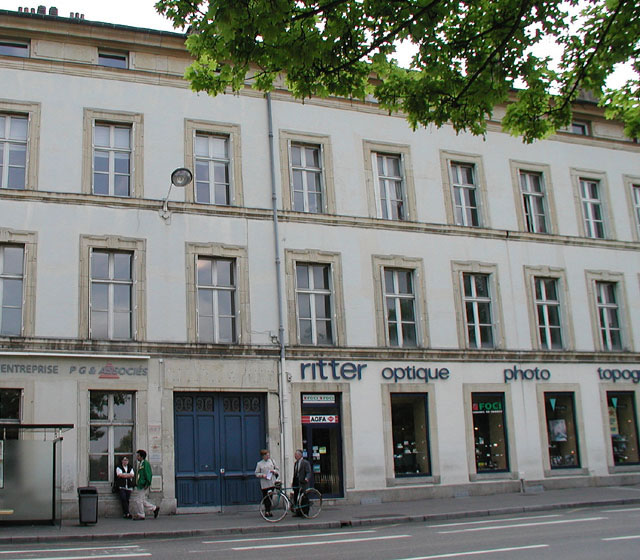
In addition, this 115mm telescope had an equatorial mount, which eventually could be motorized to do astrophotography by compensating the movement of the stars (well, in reality no… the mount was way too flimsy). It also had setting circles facilitating the pointing of said stars, I came out fascinated. Fascinated also by the price, 1330 francs, which was like two months of work if I worked during the school holidays. In January 1974, comet Kohoutek, discovered the previous year had been a majestic flop, announced at the magnitude -10 (100 times brighter than Venus, it was announced as a comet that would span a third of the sky). It became, at its best, barely visible with the naked eye (magnitude 5) and I never saw it. Without having the 1330 francs, I had decided to purchase a 76mm telescope via a mail order catalog, and I maybe wasn’t the only one, since my telescope was delivered a few weeks after the passage of the comet. 235 francs, on a table tripod with two Huyghens type eyepieces, 20mm and 6mm. It was far from the Perl quality, but I could start to observe the sky, discover the moon, the planets, and the Messier objects. And I could transport it on my moped. The 115 mm telescope stayed a dream for me, even though it was the first instrument of a generation of European amateur astronomers. Subsequently, I built and eventually bought many other telescopes, but never owned a 115/900.
If you want to know what a Perl 115/900 looks like, search on google, and you will find for example this page , found on the French webastro forum, there is even a copy of the advertisement very similar to the one that made me dream at the time.
A few years later ... many years later.
I live in Chile and, at 60 years of age, I finally have a 115 telescope ...
And it did cost me well over 1330 francs. Inflation, you know...
The story of this telescope begins by writing the words "telescope mirror" on the ebay.com web page. I look from time to time to see if there are any good deals. I already bought several mirrors on ebay, one 45cm, one 63cm and another 72cm. And that night there is such good deal: a mirror of 1m15, lightweight cellular structure, for 35000 dollars. I send an email to Norman Fullum, who is a Canadian-Quebecois optician, and who knows about cellular mirrors, since he makes some, just to see what he thought of this ebay mirror. And he thought a lot of good things, since he was the one selling it. I had not paid attention to the fact that his address was on the page. The mirror was in an auction, and I don’t like auctions, since there is always that guy with a slightly faster internet which will bid 5 dollars more than you, just 10 seconds before the end of the auction. So I talked with Norman, about the optical quality of the mirror, its origin, and a few days later we settled on a 45000 dollars price for the mirror. The mirror is made out of ULE glass (Ultra Low Expansion), and Norman told me it was a prototype for the Hubble Space Telescope mirror. Which of course was incorrect, since there have never been any prototypes for the HST mirror since the HST is derived from the Keyhole 11 spy satellite series but looking in the right (therefore up) direction.
I ended up finding part of the story of this mirror, linked to the Cold War era. If you go to the 29:54 minute of this video , you will see a mirror very similar to mine. Between the Keyhole 7 Gambit and Keyhole 8 Gambit 3, A total of 92 satellites were launched during the period 1963-1984. Forty years later a blank, a surplus, eventually was sold and ended up in Norman’s workshop. The Wikipedia pages about these satellites do talk about 48inch mirrors (1.22m mirrors), maybe mine was a prototype, maybe the person writing the Wikipedia page did not have access to all the details, or there were variations during the 21 years of existence of these secret satellites. Norman told me that when he got that mirror it was at F/5, aluminized and hyperbolic. Norman did rework it at F/3.7 and parabolic.
Once the price was set, I had to convince my wife that I really needed a telescope that big... It took me a few days, using a NASA technique (first you claim that it’s going to be built in no time and for very little money, and in the end, it took 4 years and quite a lot more money than anticipated). We went to the bank to ask for a credit line for the part of the sum which we didn’t have. A few months later, the mirror arrived in San Pedro, after having traveled by boat to the port of Antofagasta and then by truck to the house.
The mirror has the same structure found on many spy satellites mirrors, Hubble being one of the versions. The biggest amateur telescope in the world, built by a Utah amateur, measures 70 inches and is made exactly the same way (see the minute 1: 19 of this video or in the 28th second of this one ) and is that of a Keyhole 10 Dorian satellite which ended up for sale apparently because of a slight defect on the glass blank. Mine was polished by Norman Fullum at (a priori) to a tenth of a wavelength. It weighs 120kg, instead of the 440 kg of a full blank of the same diameter and the same thickness (17cm). I bought a 212x300mm secondary mirror a few months later from Discovery Telescopes in California. A possible solution was that at the time, they didn't know about Wynne correctors and other more advanced optical combination. They only knew about 2 lens Ross correctors, and when the mirror is actually a bit hyperbolic, you can get much better correction with a 2 lens only wide field corrector.
Then, what telescope to build around this mirror? It seemed obvious to me that it had to be a motorized azimutal newtonian. Making an equatorial mount would have led to a much larger telescope, certainly more expensive and much less practical in terms of visual observation. I could have made a dobsonian telescope, but to me that does not qualify as a telescope. I wanted a telescope to make visual observations certainly, but also to make useful astronomical observations, so a telescope able to point automatically to better than one arc minute (or better yet) and track several minutes, with 4 meter focal length without any problems. And this is never the case with these wooden tinkering called dobsonians. Some are better than others, but they are made for visual observation and not much else. The other thing is that in San Pedro, the air is very dry and wooden constructions do not last very long anyway. I had a little discussion with my friend Roberto Castillo, who is a mechanical engineer at the Paranal observatory, and we quickly sketched out a project. The structure would be made of aluminum casting so as to be light, except the base which is made of welded steel. The entire construction lasted almost 4 years. Roberto was only half-time on the project, his other half being in Paranal and my finances have variable geometry throughout the year. The weight of the telescope is the second issue of importance, I have no interest in moving a telescope as big as this one in a sky worse than mine. The sky of my garden is very very good. By the time I started writing the French version of this web page, it was cloudy, but it was the first time in 11 weeks. In France when the weather is nice 3 nights in a row, we are already quite happy.
There are 3 identical octagons, 2 forming the top ring, and the other supporting the mirror cell. The cell is 18 points floating triangles, the mirror being held laterally with a strap. The Serrurier assembly tubes are currently made of stainless steel, but may be replaced by carbon tubes. For visual observation, the expansion of the tube is of little importance, and in photography, once the coefficient of thermal expansion of the tube is measured, there are focusers that automatically compensate for expansion. On professional telescopes you can have a few centimeters of thermal expansion during the night and it never is a problem to take sharp images.
The central part of the tube was to be made in aluminum foundry and the workshop that was supposed to make it failed, so the central part of the tube is made of aluminum plates screwed between two square plates, with a circular hole of each side ( and these plates were made in the foundry).
For the azimuthal rotation I bought a 1m20 cross-roller bearing of inner diameter in China and it is a very satisfactory solution. At the beginning we had thought to put several small wheels on a rectified steel surface, but in the end the bearing provides very smooth rotation.
The entire telescope weighs about 2.5 tons, which is light for a telescope of this size (the ESO 1m telescope where I worked years ago weighs 6 tons, the 90cm Schmidt telescope at Calern where I worked in my youth is 32-tons).
The focal length is 4252mm which gives an aperture ratio of about 3.7. The Paracorr coma corrector increases the focal length by 15%, to 4890mm. With a 21mm Ethos eyepiece, the magnification is 233x, the exit pupil is 5mm, and the field is 25 arc minutes. A 25mm Explore Scientific eyepiece gives a magnification of 195x and therefore a field of half a degree, so the full moon barely fits into the field.
The spider is rotatable and thus allows use of 4 foci, the main focus is the visual focus, with a 2inch focuser. Eventually, there will be a focus for long-exposure photography (16803 FLI camera with a 4-inch Wynne corrector and ASA focuser), a focus with a fast camera for asteroid occultations (one of my hobbies) and certainly a focus for spectroscopy.
For the moment the finder is a 150mm refractor which has a 50mm finder which I use most of the time.
The motors will be direct drives. For this size of telescope, I only had the choice between a friction drive or a direct drive. Worm gears in the diameters required would have been way too expensive, and have periodic errors, etc... Today worm gears are an old technology. Some companies still produce mounts with worm gears, but once one has used a direct drive mount, and I have, worm gears are not an option. A friction drive would certainly have allowed me to do the visual, but not to make unguided exposures of several minutes.
I made several visits to Santiago, to the workshop of the Metalab company in which most of the parts of the telescope were built. I have some machine tools at home but none that can mill such large parts. Roberto built the mdf (medium density fiberboard) molds at home, which he later brought to the foundry, then from the foundry to the workshop. And last, from the workshop to the paint workshop. Once delivered to San Pedro, we first reassembled the tube (we, meaning the workers I have in my business and myself), put a baffle on the top ring, since the telescope will be used frequently with moon in the sky, and another light tube between the mirror cell and the central part of the tube, with two petals to protect the primary mirror during the day.
The telescope was designed to be top heavy, at least for now, when there is just an eyepiece and a focuser. In the future, more instruments will come, and for now are replaced by steel plates of approximately the same weight.
We run the tours in San Pedro 3 weeks during the month, and take a short vacation during full moon. And during these full moon, I am able to go to Santiago several times to see the progresses on the telescope. During my first visit to Santiago, I could see the top ring and the bare primary mirror cell octagon. The second trip allowed me to see the assembled tube with the secondary mirror spider installed. The third, the mount, the fourth, the central box with the rear part of the tube installed on the mount, and the last, the final assembly and disassembly before all the parts were sent to the paint shop.
The telescope arrived in San Pedro on August 20, 2018.
The telescope, its construction and its use:
The telescope is the largest telescope ever built in Chile (not counting the optics, which were built by some company contracted by the CIA, and the motors which will be made in Europe), and also the largest visual telescope in Chile. The largest Chilean professional telescope is the 70cm Maksutov telescope at Cerro Roble observatory. It was built in Russia, and offered by the USSR to Chile at the time of the idiot Allende (when both countries were enjoying communist life style). Chilean astronomers, having 10% of the time of the largest telescopes in the world, have no interest or motivation to build national telescopes as is the case in most countries which have astronomers. This is, to my knowledge, the largest telescope for visual observations in the southern hemisphere. This is not the largest telescope "in which one can observe with one's eyes" of the world. The historic 100-inch Mount Wilson telescope can be used for visual observation sessions, but the quality of the sky just north of Los Angeles is quite poor for faint objects. One can also observe visually with the McDonald Observatory telescopes in Texas, with a much better sky than that of Mount Wilson.
There are many amateurs who have much larger telescopes. Amateur Mel Bartels in the USA keeps an up-to-date list of the largest amateur telescopes in the world, but this is not a competition, and the quality of the images given by a telescope depends greatly on the quality of the sky during the observation and also of the objects observed. In this context, here at home I am privileged, as the objects of the southern sky are much more beautiful than those of the north. The Omega Centaurs and 47 Toucan globular clusters are three times larger and 2 magnitudes brighter than the "great" Hercules cluster Messier 13, and so the sight of these clusters is much more spectacular than Messier 13 in a telescope, even a larger one. Said another way, the sight of these southern globular clusters in my 1m15 telescope is much more impressive than the sight of a cluster three times smaller and six times fainter in a telescope twice as big :). There is no other nebula in the sky as beautiful, complex, impressive as the Tarantula nebula. It is very complex, a 3D vision... The northern sky is for looser (provocation mode - off).
Clearly, I enjoy myself and the pleasure continues every time I look through the eyepiece. I already received some unpleasant comments, but that's to be expected. It is not a question of "having the biggest". If all the amateurs of the world had telescopes of 2m of diameter, I will not feel less happy to have my telescope in my garden, and to be able to use it as much as I want. This is not something I dreamt of having since I was a child. When I was young, as explained above, I dreamt of having a 115mm telescope, not 115cm (although one day I will end up buying a 115/900, just to have one, they can be bought for about 150 euros on classified adds sites :)), it's just that I've had the opportunity to do it now, and I did it. If I could have done it sooner, I would have done it. Things happen, or not. In the mean time I also bought a zerodur blank of 1m50 in diameter, so I still have some margin for progression (also on ebay). I also have 2 telescopes of 60cm and one of 90cm to finish ... I have 4 RASA astrographs to put in place, etc ... The priority was given to the 115, although already usable, there are still some details to improve, especially the motorization, but soon I’ll just enjoy it, and I’ll be able to spend my days on other telescopes.
I frequently observe the occultation of stars by trans-Neptunian asteroids, and it’s frequent that these stars are faint and difficult with a 50cm telescope. Now I’ll have a little bit more light. In the same way, in long exposures, with such a scope, I’ll be able to reach above magnitude 23 and there is quite a lot of work doable on far away comets and asteroids.
Returning to visual observing, in a former life, when I worked in professional observatories, I got to observe through the 1m telescope at Pic du Midi in southern France and when I worked at Palomar observatory, also with the 1.5m telescope and even a few times with the 5m telescope (200inch). With that large scope, the minimum magnification is about 1000 times, and the field is very small, and the images always fuzzy because of the turbulence and high magnification. With the T1M Pic du Midi and the 1.5m telescope at Palomar I remember very beautiful views of some nebulae. It’s mostly the lack of money which prevented me to build a large telescope sooner. My astrotourism company works well, and I know for a fact that people who have never observed the sky are rarely impressed by the view of a galaxy in a small telescope… Here we started with a Celestron 14, a 33cm dobsonian and a 25cm Schmidt Cassegrain. Then we built larger telescopes, two 45cm, then two 60cm, then one 72cm telescope and of course the images are much better when the diameter increases. So I knew that a larger telescope would give better images. And I see that as when the tourists get close to the telescope, they are first impressed by the size of the machine, and then further impressed when they see through it. And then after the tours I will use it at my leisure in order to observe a lot of different objects.
I will not rent that telescope to amateurs. I will not let the telescope in the hands of just any person. I see that already when I rent other equipment to amateurs, some know what they’re doing, and some really do not, even when they told you they did. And I clearly have other things to do than to aim the telescope, night after night till daylight, it’s a very boring repetitive job, and I already have a repetitive job with the tours, and many, more exciting things to do. So if amateurs will want to look through the scope, they’ll just have to take a tour, and they will observe one or two objects with the scope. Friends are of course a different thing.
Piece after piece the telescope was built, then towards the end, assembled in Santiago. We do tours three weeks in a row and then stop the tours during the full moon week. I often take holidays during the full moon and I made several trips during the full moons to see the progress of the project. First there were the octagons of the tube, then the central box, which gave us trouble, then the bars of the Serrurier structure, then the assembly of the tube. Seeing the telescope plans on a pdf document is one thing, but starting to see the gear in real life was impressive. It's really an extraordinary telescope. Then the spider and the barrel pieces of the main mirror, and then the base of the telescope, which once welded was baked to release the tensions in the steel. Then installing the azimuth ball bearing, then the axles, then the base of the fork and the arms of the fork. We took almost three months to find a serious Chinese company. One estimate was not too expensive, or one was not charging enough (we sensed a scam in both cases). The cross roller bearing of azimuth is roughly the price of a C14 tube. We often talked on the phone with Roberto to discuss the different options. In June 2018, during a trip to Santiago I finally saw the assembled telescope. Roberto had made a wooden mirror, filled with sacks of sand to reach the 120 kg of the real mirror. Then the telescope was disassembled, and the parts that needed to be painted were moved to the electrostatic painting shop. The telescope arrived in San Pedro in August 2018. There were still several parts to be done, including the front baffle of the tube, the rear baffle (all galvanized sheets) doors closing the mirror to protect it from dust. It was necessary to make a hole in the ground to make a reinforced concrete base of 3x4m and 70cm thick. The austral summer 2019 was very rainy, the ground was soggy, and besides it was bad a month (never seen in San Pedro), so no tours, no money, so it had to wait till the end of March to resume work, build a small wall to bring the base of the telescope to ground level, 20m3 of concrete to make the slab around the telescope, then a diamond steel base around the base of the telescope, then assemble the telescope, then balancing it, collimating it, etc ... Which brought us to the end of July 2019 which are the first nights of observations. The project progress was limited by the funding available at a given time. I didn’t make an inventory of the number of pieces that had to be made to build the telescope, nor an estimate of the total price. A quick sum brings the price to above the price of a beautiful house in Chile. But spread over 5 years (I will finish the last credit in 2020), and paid by my company.
Visual observing:
With such a diameter, you never see very sharp images. The minimum magnification being in the 200x to 250x, if one has a seeing of 1 second of arc, the stars appear as spots of 200 to 250 seconds of arc, or 3 to 4 minutes of arc (one tenth of the diameter of the moon seen with the naked eye) so these are never points, but small discs, possibly very fine. If the seeing is 3 seconds of arc (this happens), the images appear to be 10 minutes of arc, so basically in the field, the stars appear about like a third of the full moon seen with the naked eye, they appear a bit blurry. We see stars as turbulent spots.
This being said, after first light for me it was a rediscovery of the objects of the distant sky. For now (non-motorized version) I did put a brake on altitude, consisting of a metal pad with a teflon plate that rubs on the quarter of circle which will later be used for the brake of the telescope. The telescope is a little difficult to move when you try to move it from a place near the fork, but very easy to move from the front or back of the telescope. In fact, it rotates alone when there is wind. In altitude the torque is about 2 Nm (newton meters) to start moving, and in azimuth a lot more at 120 Nm. Equipped with its brake in altitude, it is very easy to center, the object remains in the center of the field and is easy to follow.
There is a large slab of concrete around the telescope, upon which I move a wheeled ladder that allows access to the eyepiece. The current ladder is a little bit short to access to the zenith, but with azimutal telescopes it’s never a good idea to observe at the zenith anyway.
Every time I go from a given telescope to a larger new one, I spend a few nights making visual observations of the great classics of the sky. The telescope is used during my tours, but in the tours you only point at one object that everyone is watching. Outside of the tours I made several sessions, alone or with friends, and reviewed most of the celestial objects I have observed since my adolescence, and of course those of the southern sky. What comes up most often when someone observes is "wow", or for others, "la vache", "dingue" (French), "oh my god" (American), "que chulo ..." (spanish) or "la cago ..." (chileans :)). Most objects look like faintly colored versions of observatory photographs. The Orion Nebula is a very strong green. We see other shades in magenta, which are only effects of contrasts linked to the green of twice ionized oxygen, often called OIII). If the eye at night saw red, the center of the nebula, where the H-alpha emission is the highest, would be seen as white/yellow, which is not the case. The "red" light that we see is actually magenta, and is the complementary color of green, and that’s why we see this “red” around the “green”, just a contrast effect that "red" doesn't exist there. The blue planetary (NGC3918 in the Centaur, next to the Southern Cross) is seen in blue, and the homunculus (halo around the star Eta Carina) is seen as orange, but it is already the case in a telescope smaller than a 60cm. The Saturn Nebula (NGC7009) is very green too. When viewed with a UHC filter or an OIII filter, we see bright stars in green (they are bright enough for the eye to see colors). When Eta Carina is centered in a 60cm telescope, the Eta Carina star itself looks green because of the filter. And observers ask me why there is a green star in the field. With the 115, a good number of stars in the field are bright enough to be seen green with the filter. There is much more light than with a smaller telescope. In the future I will observe many more planetary nebulae. I have never been too good to see colors in celestial objects. we see the bright stars in green (they are bright enough for the eye to see colors).
What follows is a quick description of what I have already observed, after only a few nights. Difficult to put in words my visual impressions, For now, I observed (very fast description):
The moon , bad idea, without filters, I was blind for 10 minutes. With a neutral density filter, and a 25mm Explore Scientific 100° eyepiece, the moon is indeed almost all contained in the field, and the lunar terrain is so beautiful.
Saturn and Jupiter , but well limited by turbulence. They must be observed at the end of the night as the seeing is usually better. The contrasts are much better and the colors much more vivid than in a smaller telescope. There are holes of turbulence that suggest what the image would be if there was no turbulence. The satellites of Jupiter and Titan (Saturn's largest satellite) are seen as disks. Both Titan and Io are yellowish, orange. I got one evening a good seeing and Jupiter was much more beautiful than any other views I previously had in smaller telescope, very colored, and incredible details. Could not point Saturn as it was in the zenith, then the tours came and later Jupiter was set and Saturn too low. But what a view.
Stars: The ruby of the cross, a carbon star very close to beta of the cross (also called DY Crucis, it’s one of the reddest stars in the sky). Alpha Centauri, to say that the telescope also serves to spy on the neighbors. Also of course Sirius, to kill your dark adaptation for half an hour, and Sirius B of course clearly visible (unless it appears just in one of the diffraction spikes of the scope).
Open clusters: The jewel box. The color contrast is much stronger than on a smaller telescope. Also lost in NGC 3532 (the wishing well cluster).
Globular clusters: Omega Centauri and 47 Toucan obviously. They are to die for they are so beautiful. NGC121 (globular cluster in the small cloud of Magellan, located very close to Toucan 47, we can then see two globular clusters in two different galaxies, ours and the small cloud of Magellan, 15 times more distant
Planetary nebulae:M57, no more impressive than in a smaller telescope. Let's just say barely better. M27, very good, she has a pretty good size in the field, central star easily seen, some extensions. NGC246, a beautiful floating bubble in the universe, is one of the finest planetary nebulae when viewed with a UHC or OIII filter. The bug nebula in Scorpius (NGC6302), the blue planetary in the Centaur (NGC3918), NGC7009, nebula Saturn, NGC7293, the helix. Barely fits in the field Central star well visible, two shells. NGC5189 much more beautiful than in a smaller telescope. NGC2392 in Gemini (clown or eskimo nebula), very beautiful, with a sharp central star, really two rings, very very nice.
Diffuse nebulae: M42, all green, sumptuous, at first (July) was only visible at the end of the night quite low on the horizon, but it was necessary to start with that one. Since then I got very beautiful views of it, the filter is counterproductive, it's such a beautiful object. The field is obviously much smaller than with a smaller telescope. The veil nebula in Cygnus, so beautiful, with a delicacy in the convolutions of the laces. Both parts, but also the Pickering Triangle, full of details. Impressive. Eta Carina, the largest gas nebula in the sky, one of the brightest ones too, so many details all over the place. The nebula is in fact much too big to appreciate it, it's better to look first at the Hubble space telescope pictures to identify all the small dark nebulae inside and on top of the main object. Also the homonculus nebula, just around the Eta Carina star itself, very orange, with the two globes (one brighter than the other) and the dust skirt perfectly visible (see here) . In Sagittarius, M8, again, too big, overflows the field, many more structures than in a smaller telescope. Especially in the part of the hourglass (those who know will understand what part I'm talking about). M20, too beautiful, like a photo. M17, better than a photo, especially with a UHC filter. M16, well, at last I can see the three pillars. What I refuse to call “pilar of creation”, what a stupid religious name for something which tells you there is no god worrying about us. One of my favorites: NGC6520, actually an open cluster in Sagittarius, but next to a dark nebula visible as an ink spot (Barnard 86) and a beautiful orange star next to it. The small Magellanic cloud: incredible the number of nebulae scattered in there. The large Magellanic cloud. Worse, we could spend hours there. The absolute top, the Tarantula, this is the most beautiful nebula in the sky, it's really mesmerizing. It leaves you speechless. It's a hallucinatory nebula. This is my favorite object in the sky after Saturn. Near the end of the year and the beginning of the new one, you get to see the three brightest gas nebulae in the sky at the same time.
Dark nebulae: Obviously, the horsehead nebula. Without filter it's only visible in averted hallucination (regular observing : averted vision, regular observing of faint objects : averted imagination, horsehead without Hbeta filter : averted hallucination). In the 45inch telescope, clearly visible, and where the other scopes show just a dark notch over a slightly brighter sky background, here you really see the head of the horse.
Galaxies: NGC253 and NGC55, full of details, overflowing the field. NGC7331 and Stephan's quintet, for once seen with structures in these small galaxies, which normally appear rather like very little and faint fuzzies. NGC1365 and NGC1097, two absolutely beautiful southern barred spirals in the telescope. In NGC1365 we see structures in the bar, and it's like a photograph. The fornax galaxy cluster: I do not know how many galaxies seen in the region it is necessary to move the telescope on several degrees in which there is galaxy upon galaxy. The Grus triplet, NGC 7582, 7590 and 7599 is very beautiful too, with a lot of details in the galaxies, whereas usually we just see the shape. Centaurus A, with the thin slice of cheese in the middle (it's called the cheeseburger galaxy, because in the middle of the absorption band, there is a fine whitish trail). Pointing the galaxy, in fact, and in almost all the fields outside of the Milky Way, one comes across a fairly large number of tiny galaxies never seen before. Messier 104 (the sombrero), as in a picture. M31 is too big and finally not so impressive, we see the bands of dust, we resolve the stars in the clusters in the outer arms. Messier 33 on the other hand impressed me, we see a beautiful spiral structure, full of details in the arms, many regions H2. In fact the observation with a UHC filter is worth the view, reinforcing the presence of the H2 regions, a beautiful show. M65, 66 and NGC3628, lots of details inside the galaxies, but only one at a time, not the 3 in the same field.
I still have some to observe ...
This ends for the moment this description which will be completed as the year progresses ...
Pictures of the construction of the telescope:
I have placed on this page some of the many images of the telescope during its construction. I did not try to be nice or practical, just spent an hour putting the main images of the construction (ie it's not a webmaster job, just something quickly done).
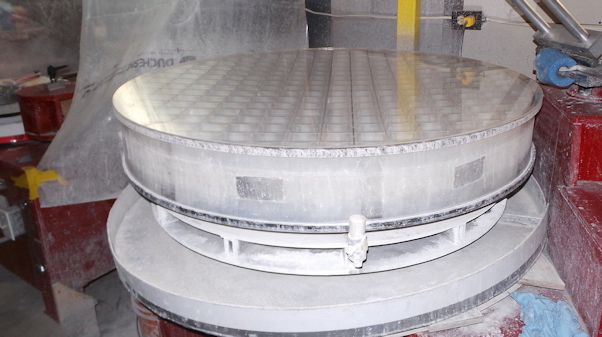
The mirror in the workshop, in Quebec. We can see the internal structure of the mirror, which is reminiscent of another mirror ... Picture by Norman Fullum.
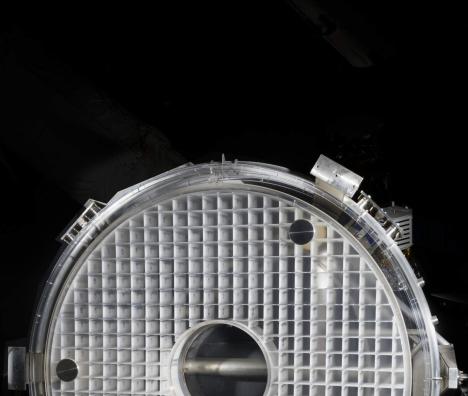
The Hubble Space Telescope mirror uses the same technology. My mirror is a mirror from a series of American spy satellites.
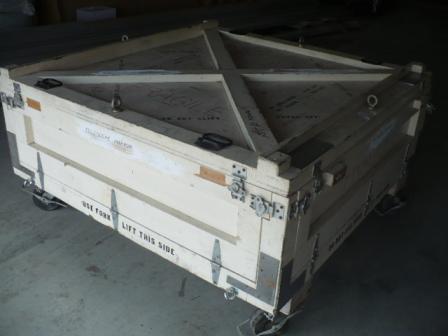
Transport box of the telescope
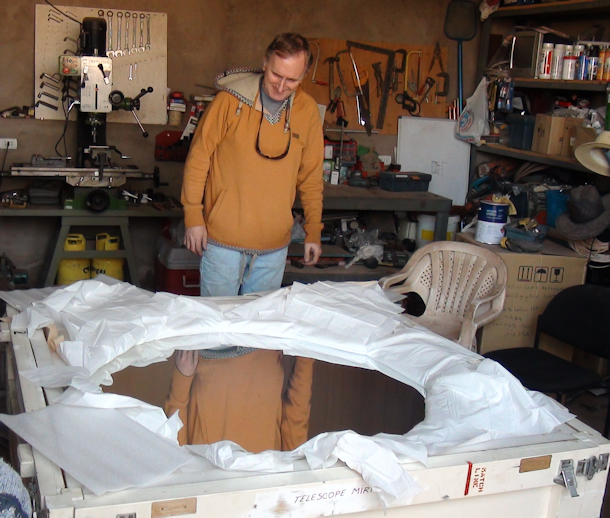
Opening of the box at the reception in San Pedro. The owner is happy.
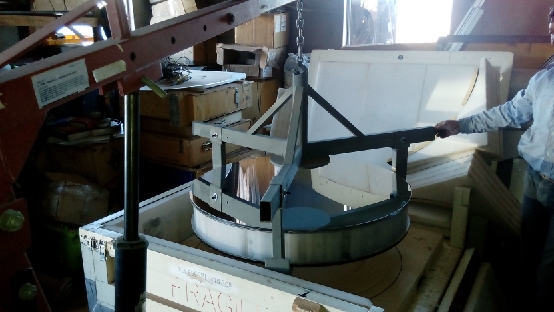
The clip we built to move the mirror.
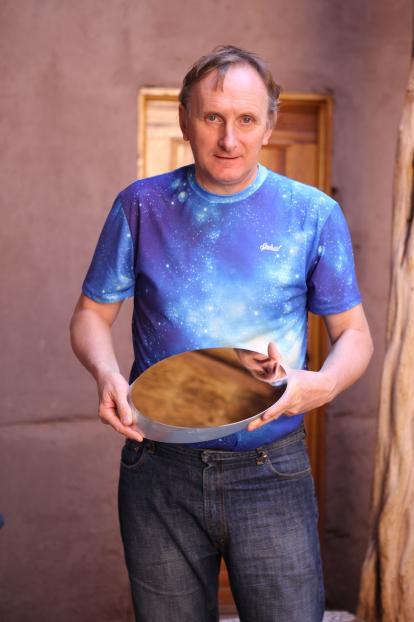
The secondary mirror at the reception.
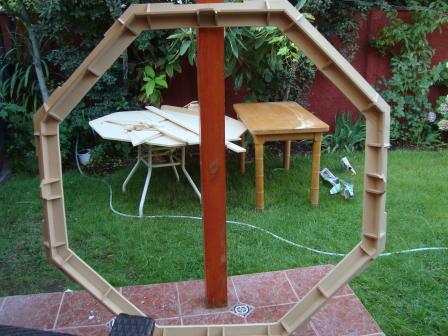
One of the first molds made in mdf, that of the octagons used in the telescope tube
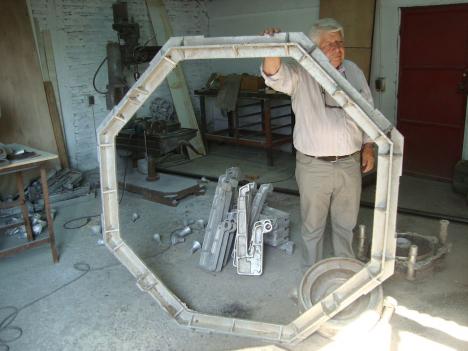
And coming out of the foundry.
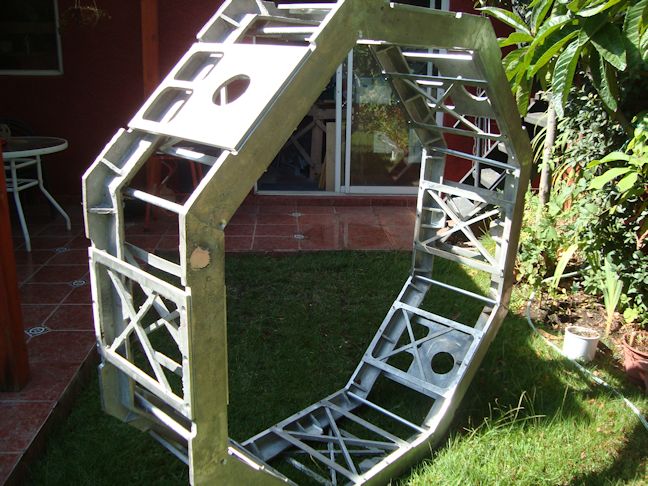
The assembled top ring
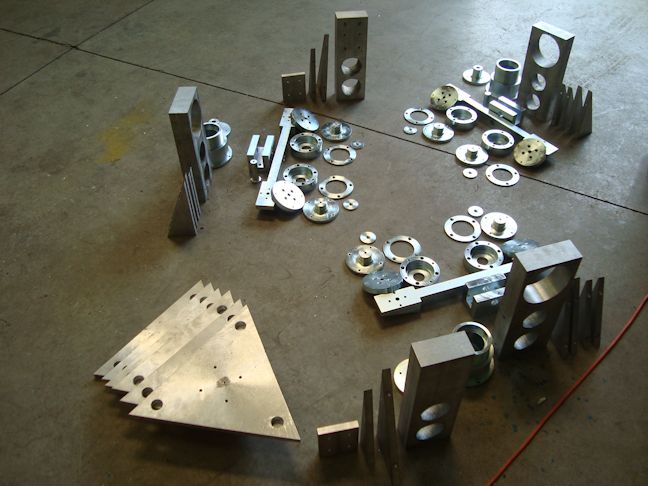
The various parts of the primary mirror cell. There are many pieces to assemble to make a telescope of this size.
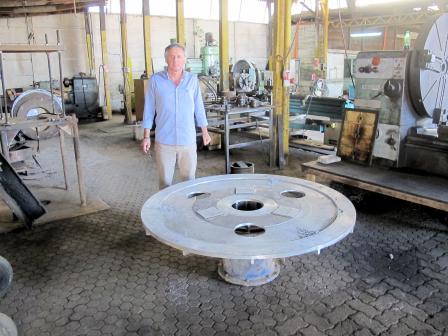
Roberto Castillo in front of the back plate (primary mirror cell). We see that the workshop is equipped with good size machines ...
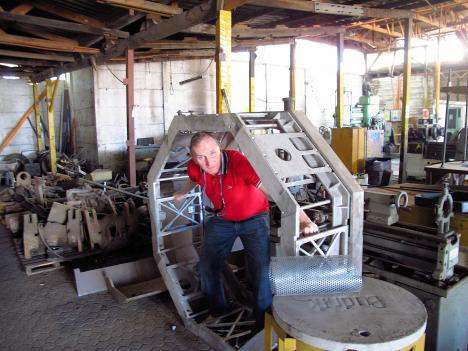
Visit to Santiago, inside the upper octagon of the tube.
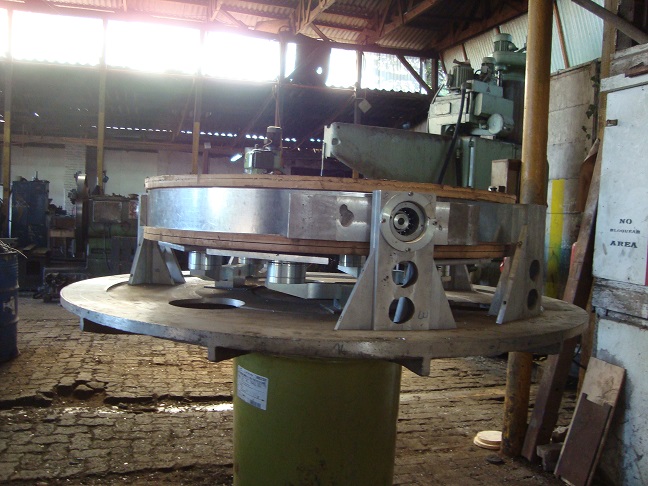
The barrel of the assembled primary mirror, with a wooden "mirror".
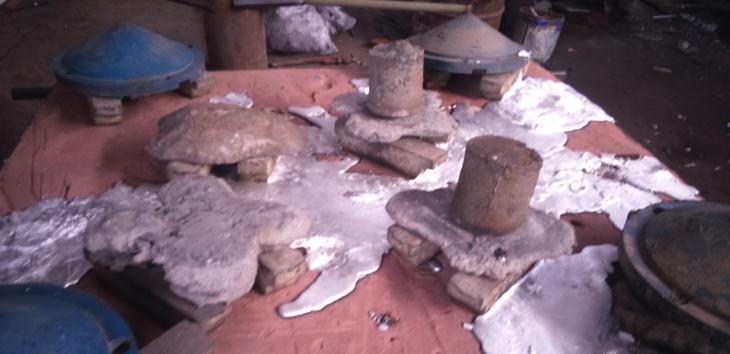
Failure : Foundry for the central box of the tube, not really a success. So we decided to make only the two front plates (a square with a big hole in the middle), the rest are aluminium plates assembled with screws.
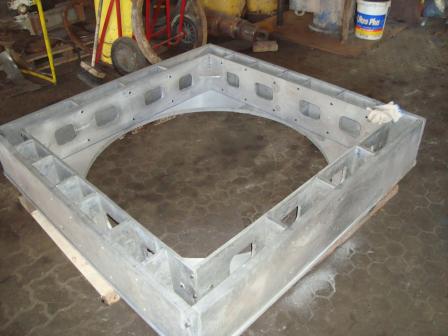
The inner part of the central box
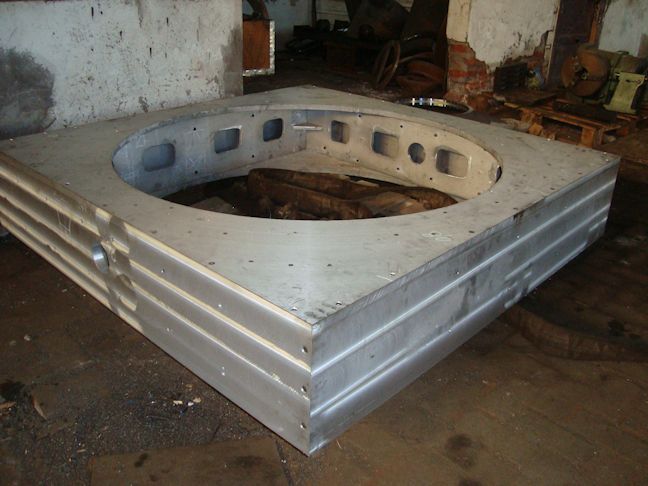
The finished central box, we see on the side one of the rectified parts in which is centered the axis of height of the tube. Everything has been rectified on a digital milling machine (large size ...).
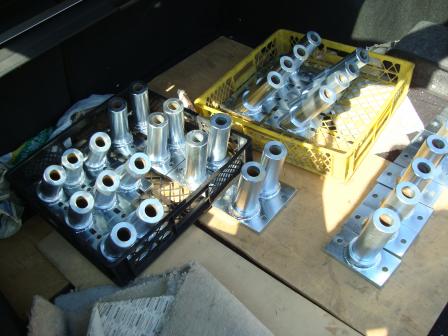
The tips of the Serrurier tubes (calculated as a real Serrurier assembly). Most hobbyists call "Serrurier Tubes" any loosely triangulated structure between the bottom of the telescope and the top ring. The Serrurier is a symmetrical structure whose bending ensures the parallelism of the primary mirror and the top ring of the telescope tube.
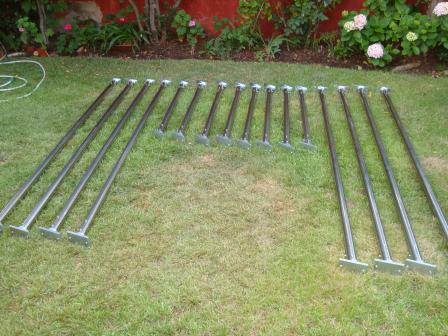
The Serrurier tubes
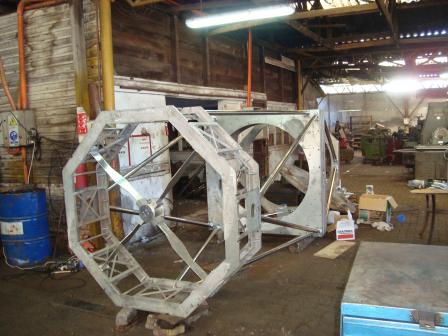
First image of the assembled tube.
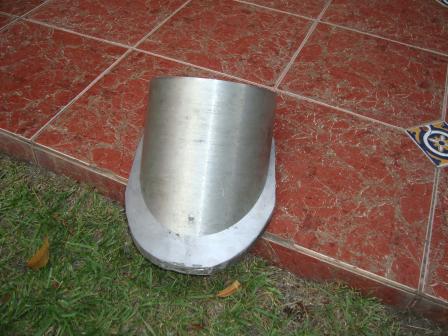
Secondary mirror support
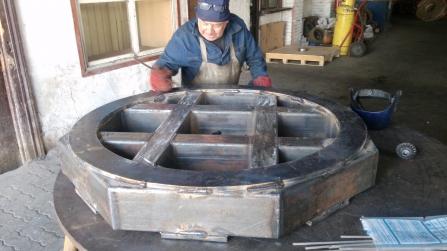
The base of the telescope mount
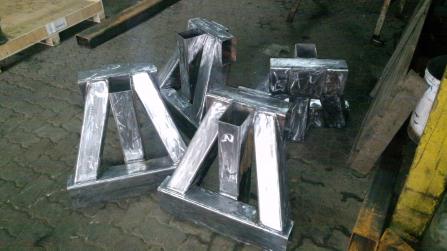
The 4 legs of the telescope. In the finished version, each leg is mounted on the base and there are 4 threaded rods that adjust the horizontality of the base (or the verticality of the azimuth axis).
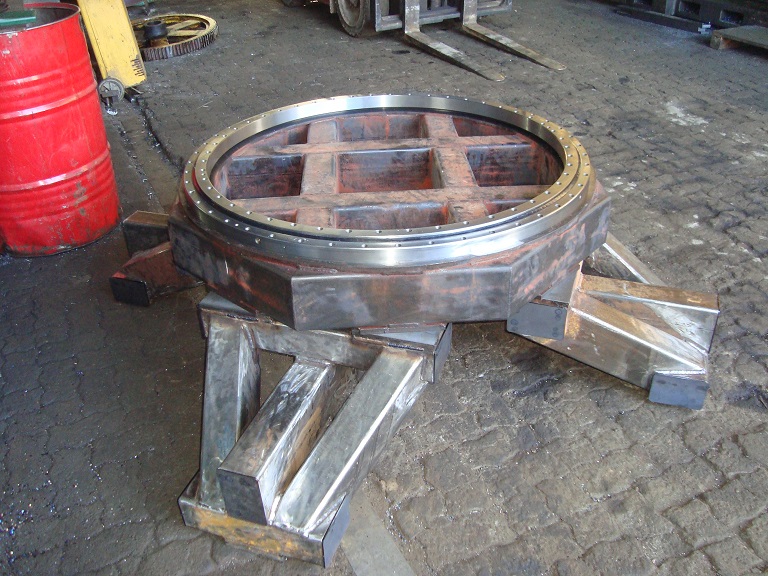
The base of the telescope, with the crossed roller bearing installed.
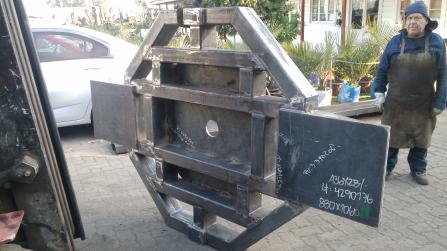
The base of the fork of the telescope. There are quite a few hours of cutting and welding to get there.
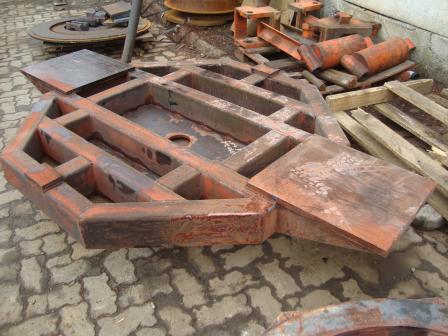
The same, after annealing in an oven.
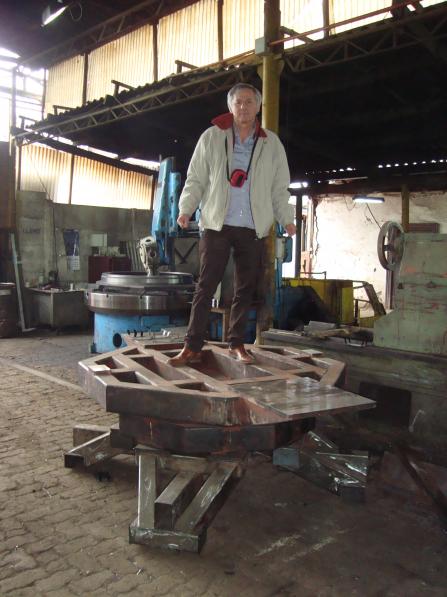
First assembly of the base of the mount.
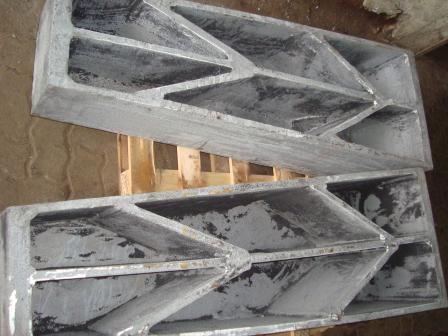
Fork arms, raw foundry
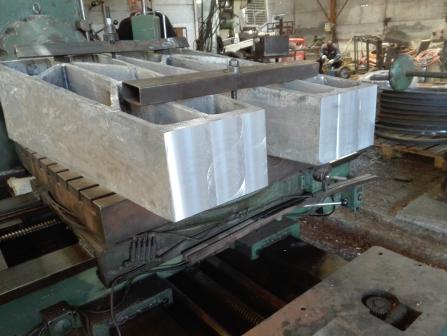
rectifying the fork arms
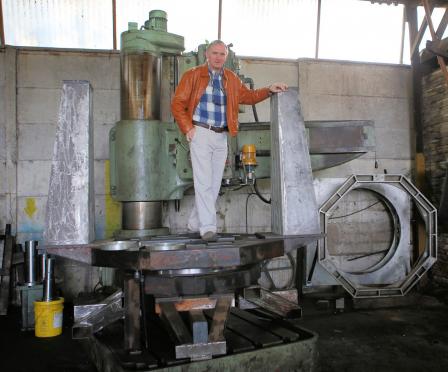
The mount almost finished (during a visit to Santiago)
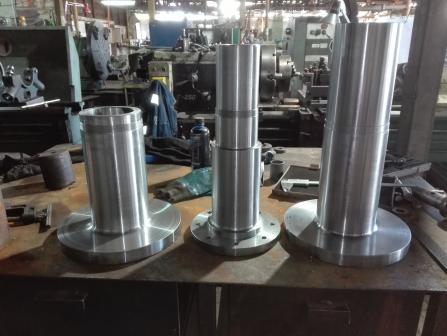
From left to right, altitude axis, long altitude axis (which will receive the direct drive motor) and azimuth axis.
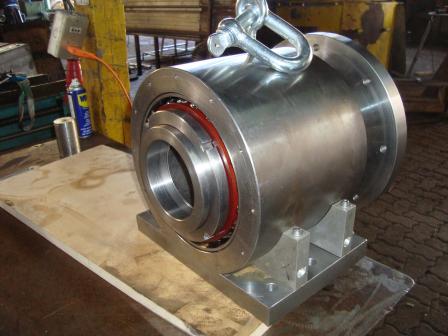
One of the axes of altitude
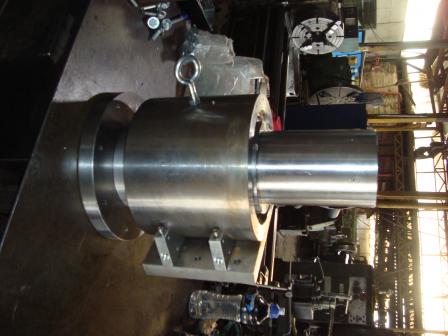
The second altitude axis (intended for mounting the altitude motor)
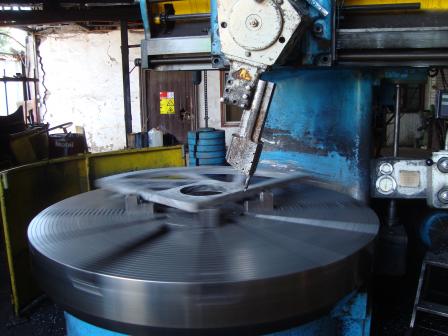
Rectification of the quadrant that will serve to brake the telescope in altitude
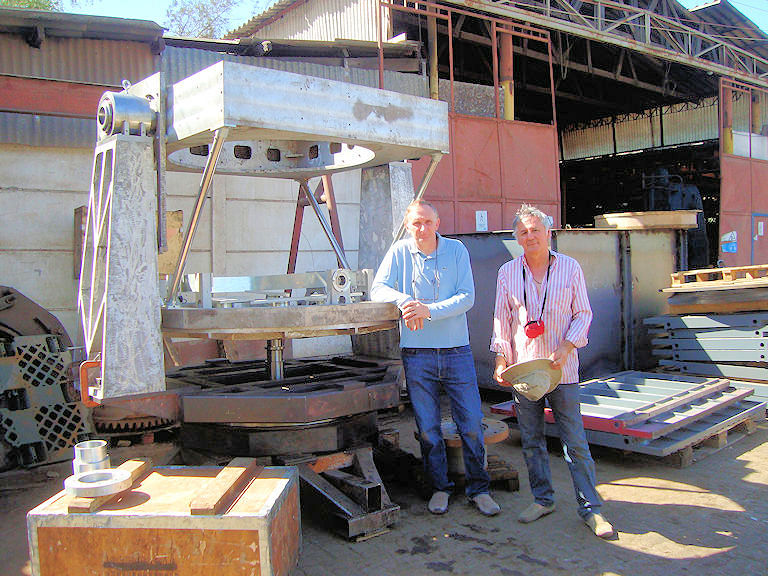
Assembly of the central box on the mount. The azimuth axis was mounted upside down (upward) to check for concentricity and centering of the telescope tube in the fork.
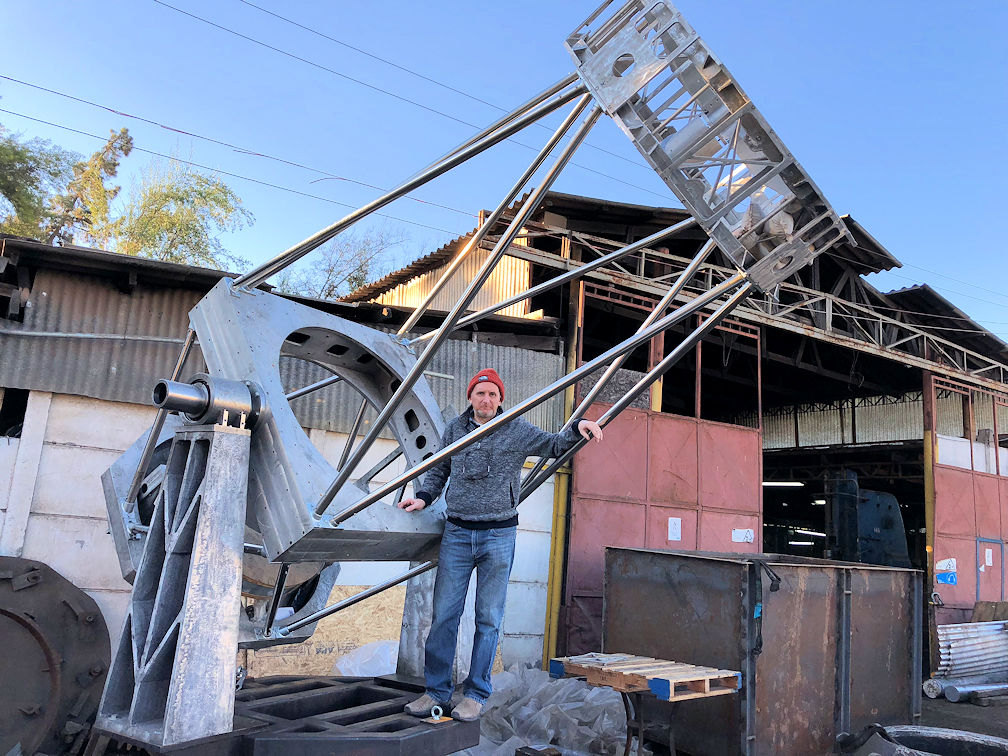
The telescope almost finished (at the Metalab workshop).
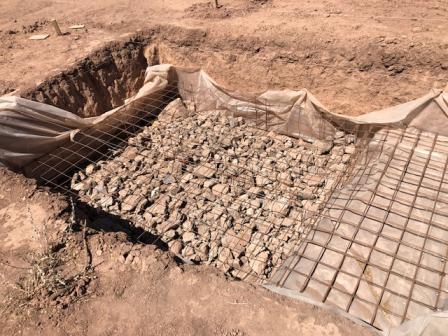
In San Pedro, hole in the ground, pouring a slab 70cm thick. We then built 4 low walls to reach the ground level, then a concrete slab around the telescope to move the observing ladder. The plastic sheet visible around the slab is to prevent the salt contained in the soil from coming into contact with the wet concrete.
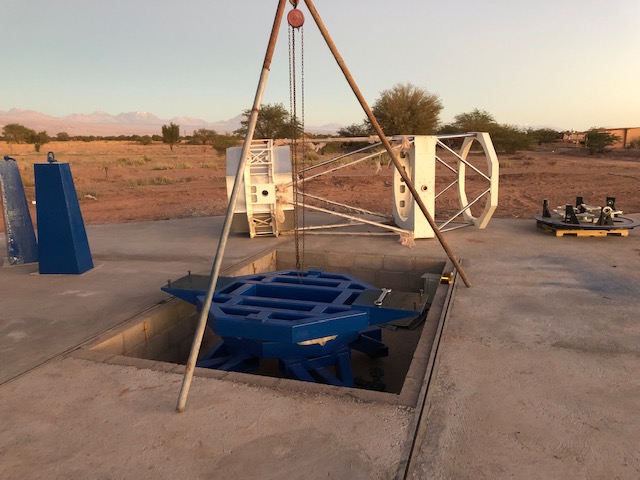
On April 27, 2019, it starts to take shape. The base of the telescope is mounted, the various parts are around their final destination. There is now a baffle around the top ring. The concrete is dry.
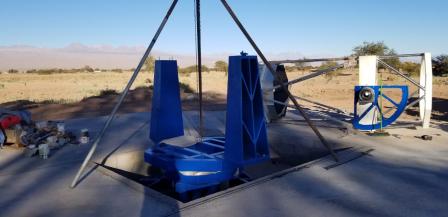
Fork arms installed, and altitude shafts are mounted on the tube (in the background).
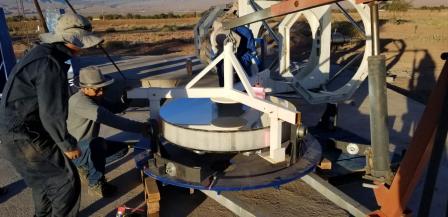
Installation of the primary mirror in its cell
MP4 video (20 MB) of installation of the tube on the fork, 31st May 2019
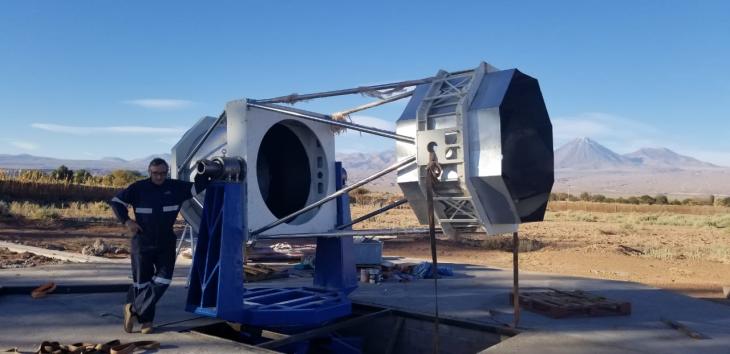
Tadaaa ... (baffle installed in the lower part of the tube, but the doors which protects the mirror are not yet installed.The side plates of the fork arms are not yet mounted. The hole in which the base of the telescope is, is not yet covered.
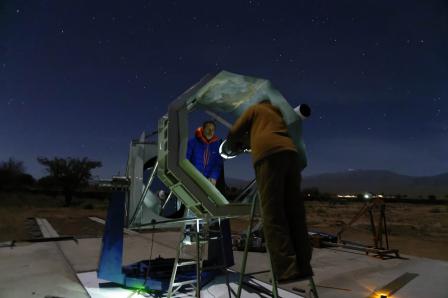
First night collimation tests. I am in front of the telescope, and in front of me, there is a French amateur who has built some mirrors ... Just a few ... (Jean Marc Lecleire is a very well known french optician). The metal plate that covers the slab of the telescope is installed. We can see backwards the rails on which will move the rolling roof shelter that will protect the telescope.
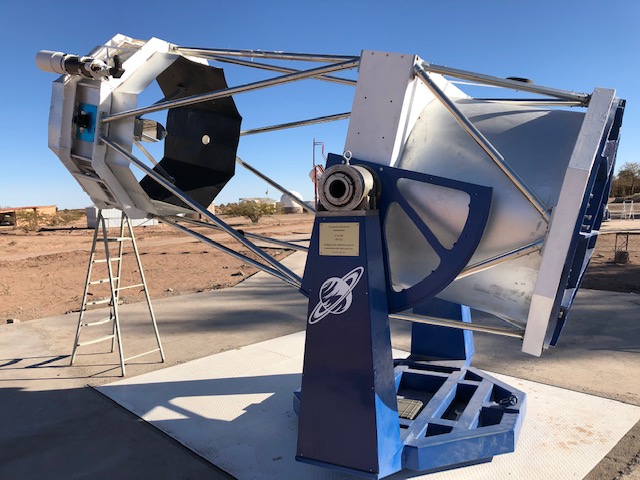
The telescope almost finished, the finder is a 150mm Skywatcher refractor.
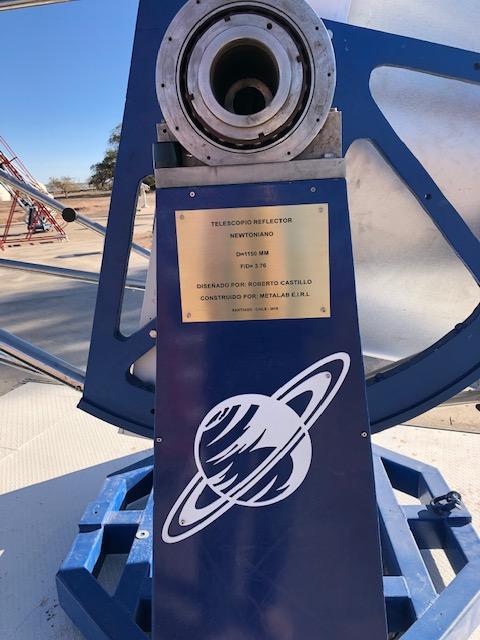
On the arm of the fork, the builder's plate, and a sculpture by Damaso Garcia, which is a steel metal plate, cut with a torch, representing one of the planets of the solar system.
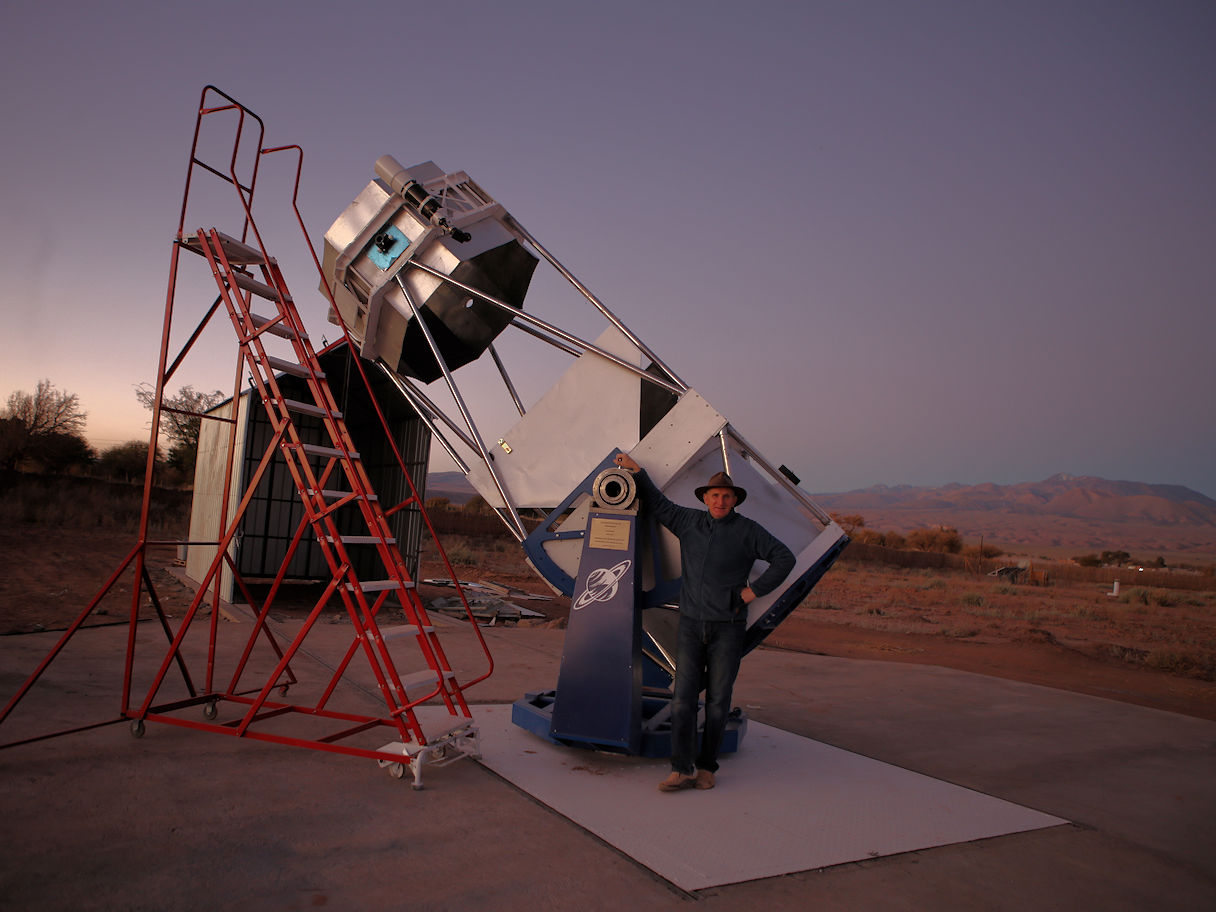
Here is an image of the telescope in its current configuration, with the roll off roof in the back, and the tall red ladder used to access the eyepiece. The former Ethos 21mm eyepiece was replaced by an Explore scientific 25mm (100° field of view) giving 30 arc minutes field of view. I can kill my eye looking at the full moon :).
Apart from the motorization, I have to install a set of fans around the primary mirror in order to speed up the thermal equilibrium of the mirror...
For now this is the end of this page, I will add images if and when necessary.
Thanks to Malcolm Park for rereading this english version.
21-10-2025  | 29-10-2025  |
05-11-2025  | 12-11-2025  |





